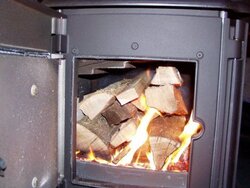Being new heating with a wood stove, this site has been very helpful, thank you.
This might be a silly question, but when you guy are talking about "packing" the stove trying to get the longest burn you can, how much are you packing into it?
I have a castine and basically put 3 or 4 smaller splits and a slightly larger one in it. But there is always room for more. I have a good 3- 4" clearance top of the pile to the lowest part of the top of the stove and a good 4-5" of clearance at the front. I didn't think i should have the wood touching or within an inch of the top, but i don't know.
Anyone have pictures of a "packed" stove
This might be a silly question, but when you guy are talking about "packing" the stove trying to get the longest burn you can, how much are you packing into it?
I have a castine and basically put 3 or 4 smaller splits and a slightly larger one in it. But there is always room for more. I have a good 3- 4" clearance top of the pile to the lowest part of the top of the stove and a good 4-5" of clearance at the front. I didn't think i should have the wood touching or within an inch of the top, but i don't know.
Anyone have pictures of a "packed" stove



